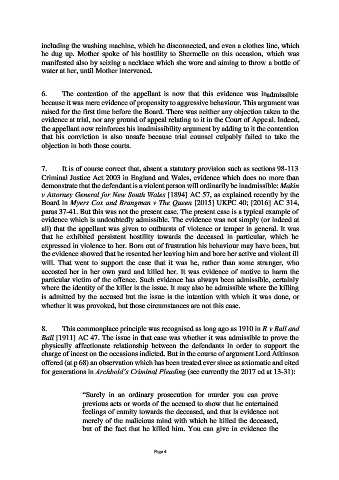Page 484 - Magistrates Conference 2019
P. 484
including the washing machine, which he disconnected, and even a clothes line, which
he dug up. Mother spoke of his hostility to Shermelle on this occasion, which was
manifested also by seizing a necklace which she wore and aiming to throw a bottle of
water at her, until Mother intervened.
6. The contention of the appellant is now that this evidence was inadmissible
because it was mere evidence of propensity to aggressive behaviour. This argument was
raised for the first time before the Board. There was neither any objection taken to the
evidence at trial, nor any ground of appeal relating to it in the Court of Appeal. Indeed,
the appellant now reinforces his inadmissibility argument by adding to it the contention
that his conviction is also unsafe because trial counsel culpably failed to take the
objection in both those courts.
7. It is of course correct that, absent a statutory provision such as sections 98-113
Criminal Justice Act 2003 in England and Wales, evidence which does no more than
demonstrate that the defendant is a violent person will ordinarily be inadmissible: Makin
v Attorney General for New South Wales [1894] AC 57, as explained recently by the
Board in Myers Cox and Brangman v The Queen [2015] UKPC 40; [2016] AC 314,
paras 37-41. But this was not the present case. The present case is a typical example of
evidence which is undoubtedly admissible. The evidence was not simply (or indeed at
all) that the appellant was given to outbursts of violence or temper in general. It was
that he exhibited persistent hostility towards the deceased in particular, which he
expressed in violence to her. Born out of frustration his behaviour may have been, but
the evidence showed that he resented her leaving him and bore her active and violent ill
will. That went to support the case that it was he, rather than some stranger, who
accosted her in her own yard and killed her. It was evidence of motive to harm the
particular victim of the offence. Such evidence has always been admissible, certainly
where the identity of the killer is the issue. It may also be admissible where the killing
is admitted by the accused but the issue is the intention with which it was done, or
whether it was provoked, but those circumstances are not this case.
8. This commonplace principle was recognised as long ago as 1910 in R v Ball and
Ball [1911] AC 47. The issue in that case was whether it was admissible to prove the
physically affectionate relationship between the defendants in order to support the
charge of incest on the occasions indicted. But in the course of argument Lord Atkinson
offered (at p 68) an observation which has been treated ever since as axiomatic and cited
for generations in Archbold’s Criminal Pleading (see currently the 2017 ed at 13-31):
“Surely in an ordinary prosecution for murder you can prove
previous acts or words of the accused to show that he entertained
feelings of enmity towards the deceased, and that is evidence not
merely of the malicious mind with which he killed the deceased,
but of the fact that he killed him. You can give in evidence the
Page 4

